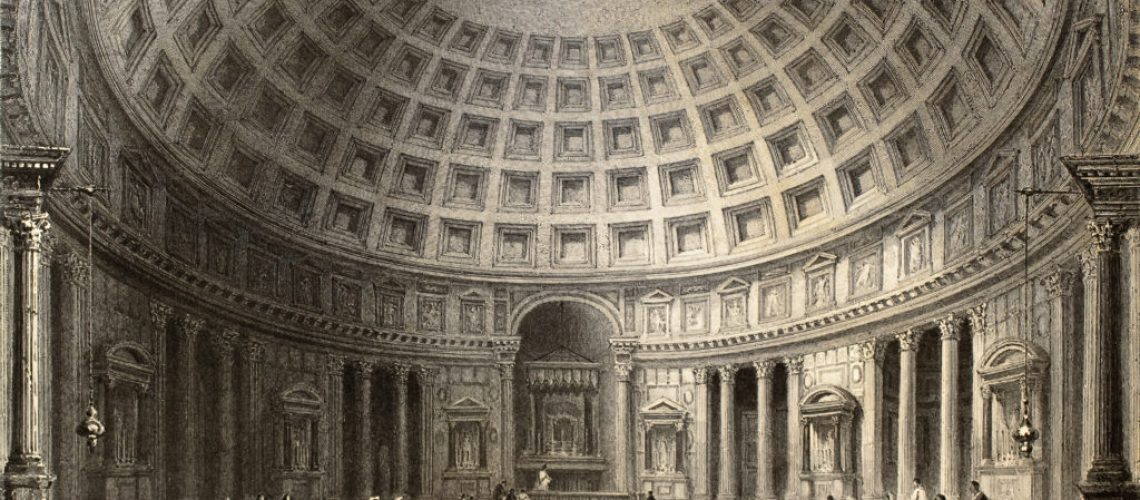The history of interior design dates back to the early era of human civilization. For instance, rich furniture made of priceless metals and stones, colorful paintings, and elaborate symbols decorated ancient Egyptian homes. These interiors had great cultural and philosophical importance in addition to being functional; every piece was carefully picked to suggest riches, power, and spirituality. Read on to learn how home design has evolved over the ages, and how history still influences interior design today.
Classical Examples
Following the Egyptian civilization, the practice of interior design was further developed by the classical societies of Greece and Rome. Greek interior design was defined by natural materials such as marble, stone, and wood, as well as simplicity, symmetry, and harmony. Roman interior design, on the other hand, was more rich and luxurious, with ornate mosaics, frescoes, and furniture that were inspired by the empire’s wealth.
The master bathroom of this custom home we built in Clearwater included a number of Classical-inspired details, such as the raised tub, the symmetry, and the marble.
Medieval Magnificence
Interior design changed dramatically during the Middle Ages as Europe descended into the medieval era. Stained glass windows, elaborate tapestries, and towering ceilings all combined to create a feeling of magnificence that made castles and cathedrals the focal points of architectural innovation. The feudal system had a significant impact on interior design as well; expensive furniture and decorations served as status and wealth markers in royal homes.
You could say that Medieval design helped influence the dining room of this luxury home we remodeled in Clearwater. With its dramatic wallpaper, elegant crown molding, candelabra-style chandelier, and richly colored rug, as well as the long dining table to accommodate large parties, the space is reminiscent of the opulence of the royal class during the Middle Ages.
The Renaissance
Classical design ideas had a resurgence in Europe during the Renaissance, which was characterized by a rebirth of creative and cultural expression. Interior design started to emphasize symmetry, perspective, and balance more, and the result was more harmonious and proportional spaces.
Renaissance influences can be seen in this home we remodeled in the Harbor Oaks district of Clearwater.
Industrial Revolution
Significant developments in interior design occurred with the start of the Industrial Revolution in the 18th and 19th centuries. The widespread availability of furniture and décor made possible by mass manufacturing processes contributed to the democratization of design. Interior design grew more practical and useful, emphasizing comfort and efficiency.
The offices we built in Station Square in Clearwater many years ago included a number of modern industrial influences, from the light fixtures and open ceiling to the steel doors and concrete floors.
The Modernist Movement
The modernist movement, which discarded the elaborate extravagance of the past in favor of invention, simplicity, and utility, rose to popularity in the 20th century. Architects like Frank Lloyd Wright and the Bauhaus School of Design aimed to create environments that were as much about function as aesthetics. Clean lines, geometric shapes, and the use of industrial materials like concrete, steel, and glass were all highlighted in modernist interior design.
This home we remodeled in Treasure Island had a modern industrial spin to it, as you can see in the clean lines, geometric light fixture, and the materials used (glass, stainless steel, and concrete countertops). This kitchen also focused heavily on functionality, capitalizing on modern conveniences like SMART Technology.
Current Patterns
The ever-evolving preferences and habits of society are reflected in the ongoing evolution of interior design today. A combination of global influences, materials, and styles characterizes contemporary interiors. Designers are progressively incorporating energy-efficient technology and renewable materials into their creations, demonstrating the growing importance of sustainability and environmental concern. In today’s dynamic and varied design world, the options are unlimited, ranging from colorful Bohemian elegance to minimalist Scandinavian design.
The kitchen of this home we remodeled in Brandon, Florida, incorporated the ever-popular transitional style, which combines both modern and traditional elements.
In Summary
The development of interior design throughout history is evidence of human intelligence, creativity, and cultural diversity. One thing is clear: interior design will always be an art form that accompanies and inspires human evolution.
Nelson Construction and Renovations, a family business founded in 2006, is a design-build company that specializes in high-end remodels, home additions, and custom homes. With our headquarters in Clearwater, Florida, we serve homeowners all over Pinellas and Hillsborough Counties. We are an award-winning member of the National Association of the Remodeling Industry and have an A+ rating with the Better Business Bureau.
Creative Commons Attribution: Permission is granted to re-post this article in its entirety with credit to Nelson Construction and a clickable link back to this page.
The post Exploring the Rich History of Interior Design first appeared on Nelson Construction & Renovations, Inc..
